To create stunning patinas on your rings, try classic liver of sulphur for rich browns, ammonia fumes for vibrant blues, or salt and vinegar for emerald greens. Heat titanium to produce rainbow effects or master Japanese Rokushō for deep greens to blue-blacks. For contrast, explore selective patination with careful masking techniques. Don’t forget to protect your work with Renaissance wax or lacquer. These ten methods will transform your simple metal into wearable art with unique character.
Classic Liver of Sulphur Patina for Vintage Appeal
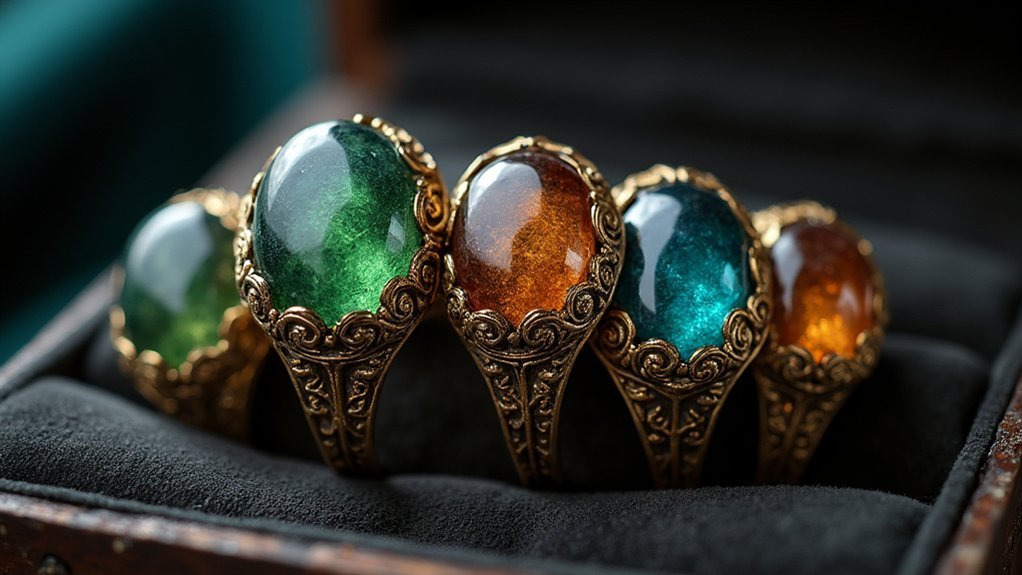
When seeking to transform your metal jewelry pieces with an authentic vintage appearance, few techniques rival the classic liver of sulphur patina method. This versatile treatment creates rich, dimensional finishes on silver, copper, and bronze surfaces that enhance textural details.
To achieve a striking black patina color, mix approximately 10 drops of liver of sulphur with half a mug of hot water. Dip your thoroughly cleaned ring into the solution until you reach your desired depth, then immediately rinse with cold water to halt the reaction.
The perfect black patina emerges when your metal meets precise chemistry—ten drops, hot water, patience, and a decisive cold rinse.
You’ll find that water temperature and solution concentration dramatically affect results—experiment to achieve colors ranging from subtle yellow to deep ebony.
Always seal your finished patina with Renaissance wax or lacquer to preserve the effect and prevent future tarnishing.
Heat-Induced Rainbow Effects on Titanium Rings
Titanium rings offer a completely different approach to patination than their silver counterparts. When exposed to heat, these metals undergo an oxidation process that creates stunning rainbow hues ranging from gold to deep purple.
You’ll need a torch or heat gun to achieve these effects. For light gold tones, heat your ring to approximately 300°F, while temperatures around 600°F produce rich blues and purples. Control the heat application by moving in circular motions to create unique color patterns that are entirely your own.
The resulting patina is durable, though you should handle your creation carefully to prevent scratching.
Try experimenting with different heating techniques and durations—each approach yields distinctive results, ensuring your titanium ring displays coloration that can’t be replicated exactly, even by the most skilled artisans.
Ammonia Fume Blue Patination Technique
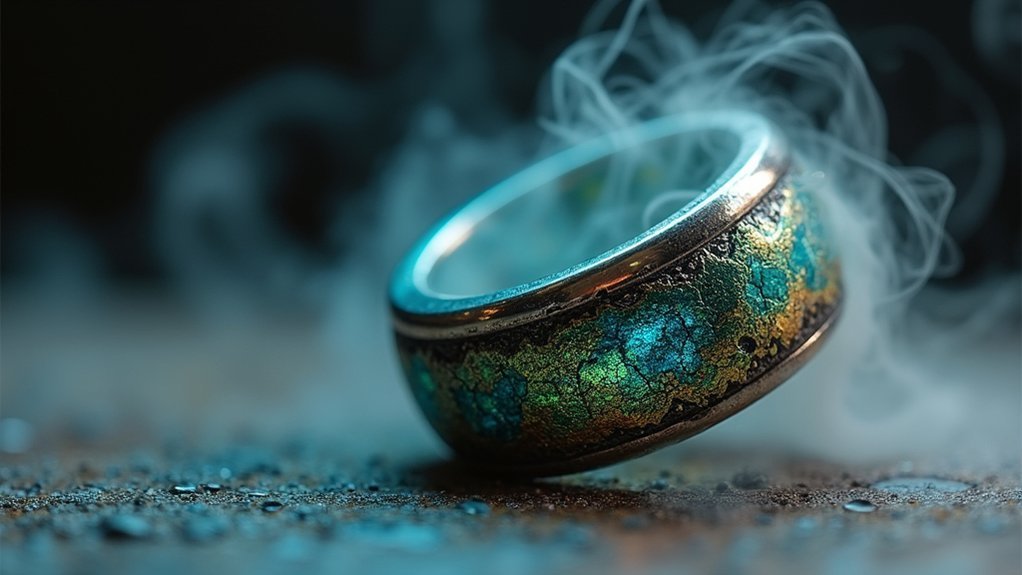
One of the most dramatic transformations you’ll witness in metal patination comes from the ammonia fume technique, which creates breathtaking blue finishes on copper rings.
To achieve this stunning patina, place your copper ring in a sealed chamber with ammonia-soaked paper towels, ensuring no direct contact between the metal and liquid. The ammonia vapors react with the copper surface to develop its visual appeal.
| Process Step | Duration |
|---|---|
| Chamber setup | 5 minutes |
| Initial reaction | 30 minutes |
| Full color development | 2-6 hours |
| Salt variations | As desired |
| Protective sealing | 15 minutes |
Experiment with salt concentrations for unique blue variations. Once you’ve achieved your perfect shade, apply a protective lacquer or wax to preserve your ring’s vibrant blue finish against future oxidation.
Salt and Vinegar Green Verdigris Method
Unlike the blue ammonia patina, the salt and vinegar method creates a stunning emerald-green verdigris finish that jewelers cherish for its organic, weathered appearance.
This patina involves combining equal parts table salt and white vinegar to form a reactive paste that accelerates oxidation on copper or brass surfaces.
To create patina with this technique:
- Mix salt and vinegar into a thick, spreadable paste and apply evenly across your ring’s surface.
- Wrap the coated ring in plastic wrap to maintain humidity and enhance chemical reactions.
- Allow the wrapped piece to rest overnight as the verdigris develops its characteristic green hues.
- Rinse thoroughly when desired color depth is achieved, then dry completely before sealing.
For more dynamic results, try heating the metal slightly before application or varying your salt-to-vinegar ratio.
Mastering Japanese Rokushō Patina for Rings
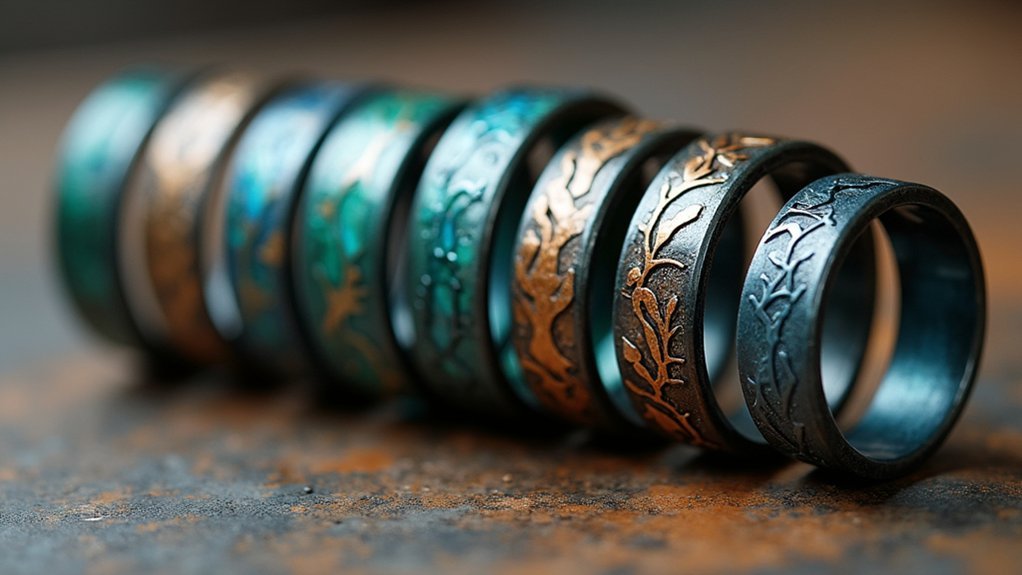
Dating back centuries in Japanese metalwork tradition, Rokushō patina offers ring artisans a sophisticated method for achieving rich, complex finishes ranging from deep forest greens to mysterious blue-blacks.
This technique transforms copper and brass rings through a controlled chemical reaction when immersed in a copper sulfate solution.
Your success depends on precision—carefully monitor solution concentration, water temperature, and immersion duration.
Too long in the bath and you’ll overpower the patina; too brief and colors won’t develop fully.
After achieving your desired shade, thoroughly rinse the piece in clean water to halt the reaction.
For lasting beauty, apply a protective wax or lacquer coating that preserves the patina against humidity and daily wear.
This ancient Japanese technique not only enhances your ring’s visual depth but also creates a protective layer that honors metalworking heritage.
Controlled Rust Patinas for Iron-Based Jewelry
Three distinctive approaches exist for creating controlled rust patinas on iron-based rings, each yielding unique textural and color results.
You’ll achieve beautiful oxidation effects by applying vinegar-salt mixtures to accelerate the aging process. For more vibrant reddish-brown tones, combine hydrogen peroxide with salt.
To perfect your controlled rust patinas:
- Create a consistent environment using a sealed container with vinegar-soaked cloth
- Apply heat with a heat gun to intensify color variations across the surface
- Experiment with different solution strengths for varied texture depths
- Seal completed patinas with clear lacquer or wax to prevent flaking
To maintain the patinas long-term, guarantee proper sealing after achieving your desired effect.
This protective layer prevents deterioration while preserving the rustic character that makes these finishes so distinctive.
Black Oxide Finishes for Modern Ring Designs
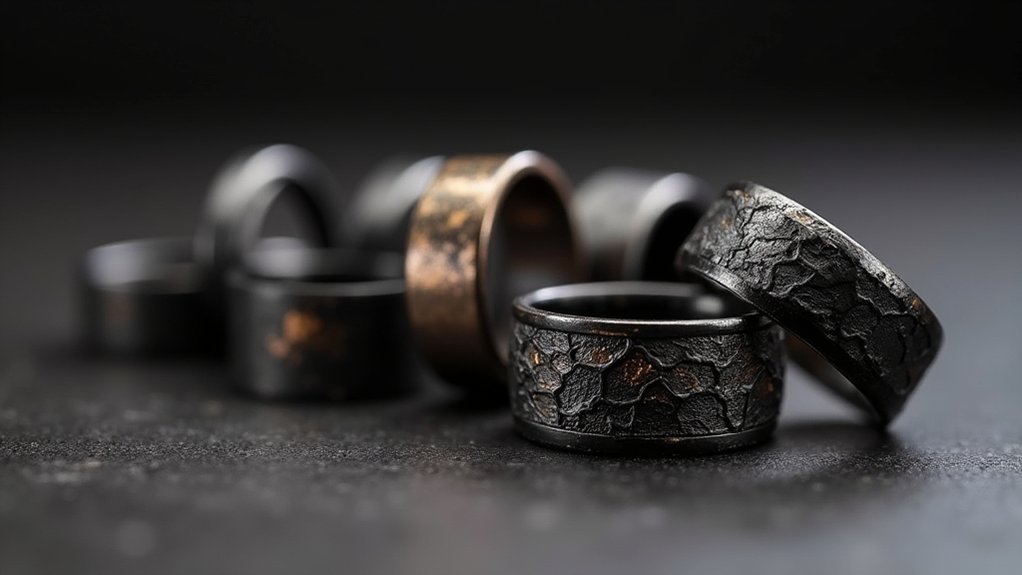
You’ll find black oxide finishes offer precise control over patination intensity through varied chemical exposure times and solution strengths.
This industrial-inspired treatment transforms your modern ring designs with dramatic contrast, highlighting textural details that might otherwise be overlooked.
The sleek matte appearance creates a sophisticated contemporary aesthetic while providing practical benefits like improved corrosion resistance and reduced light reflection.
Oxidation Control Techniques
While many ring enthusiasts seek to prevent oxidation, modern design aesthetics have embraced controlled oxidation as an artistic technique.
To master these oxidation control techniques, you’ll need to understand the chemical reactions that create beautiful patina effects.
- Immerse your ring in a sodium hydroxide and sodium nitrite solution heated between 140°F to 180°F to achieve that coveted black oxide finish.
- Control immersion time precisely—shorter periods create subtle gray tones while longer baths develop deep, rich blacks.
- Immediately quench the piece in cold water to halt the oxidation process at exactly your desired shade.
- Seal your work with a protective coating to preserve the patina and prevent unwanted oxidation from environmental exposure.
The beauty of controlled oxidation lies in its customization potential and the distinctive character it brings to contemporary ring designs.
Industrial Aesthetic Benefits
The controlled oxidation techniques discussed earlier lead naturally to one of their most striking applications: black oxide finishes for modern ring designs. You’ll find this treatment creates a sleek, contemporary look while adding protection against corrosion and everyday wear.
Unlike traditional patinas featured in jewellery making tutorials, black oxide delivers a dramatic industrial edge that can transform even simple designs. The finish ranges from deep midnight black to subtle charcoal, highlighting textures and details with an antique look that feels distinctly modern.
| Metal Type | Finish Appearance | Durability | Best Applications |
|---|---|---|---|
| Steel | Deep matte black | Excellent | Bold statement rings |
| Copper | Charcoal black | Good | Textured bands |
| Brass | Soft black | Moderate | Mixed metal designs |
| Silver | Gunmetal black | Good | Contemporary settings |
Two-Tone Selective Patination Techniques
To achieve striking two-tone patina effects on your rings, you’ll need precise masking techniques that create clean boundaries between different finishes.
Apply masking tape or protective wax to shield specific areas while you treat others with contrasting solutions, ensuring clear separation between light and dark sections.
When working with gold-platinum combinations, leverage their natural material differences by applying selective oxidation that darkens platinum areas while maintaining gold’s warm luster, creating sophisticated contrast without compromising either metal’s integrity.
Masking for Selective Effects
Creating dramatic contrasts between pristine metal and richly patinated surfaces requires mastering selective masking techniques. When applying these masking techniques, you’ll need precise materials like painter’s tape, wax, or liquid latex to protect specific areas you want to keep untreated. The key to successful selective patination lies in clean application and careful removal.
- Imagine crisp lines dividing darkened bronze and gleaming silver on a statement ring.
- Picture geometric patterns where oxidized sections frame polished metal highlights.
- Visualize delicate floral designs with patinated backgrounds and bright metal details.
- Envision two-tone bands with contrasting patina that catches light from different angles.
After applying your patina solution, monitor the reaction closely and remove the masking carefully to preserve the sharp boundaries between your treated and protected surfaces.
Gold-Platinum Contrast Techniques
When working with mixed-metal rings containing both gold and platinum, you’ll discover unique opportunities for dramatic contrast through selective patination. Gold remains naturally resistant to tarnishing while platinum readily accepts patina, allowing you to create stunning two-tone effects.
Using liver of sulphur on platinum areas adds depth and character while gold maintains its brilliant luster. Apply the solution with a fine brush for precise control over the contrast boundary.
| Patina Level | Exposure Time | Visual Effect |
|---|---|---|
| Light | 10-30 seconds | Subtle gray |
| Medium | 1-2 minutes | Charcoal tone |
| Dark | 3-5 minutes | Deep black |
| Variegated | Multiple dips | Textured look |
Remember to protect gold sections during application—this preservation of gold’s natural brilliance against platinum’s rich patina creates the striking visual tension that makes this technique so effective.
Protective Wax and Lacquer Finishing Methods
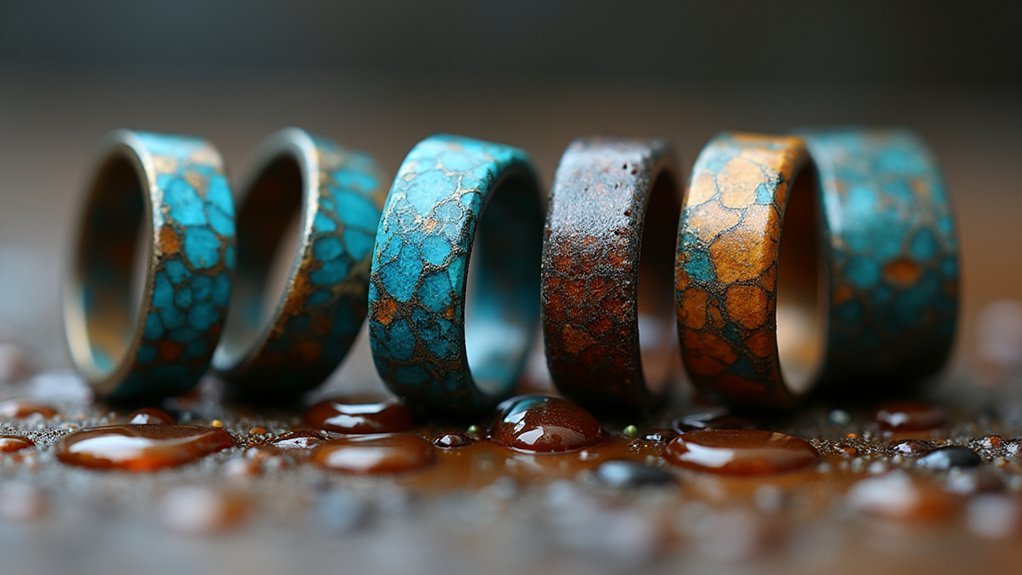
Several protective options exist for preserving your ring’s beautiful patina once you’ve achieved the desired effect.
Applying protective waxes like Renaissance or Butcher’s Wax creates an effective moisture barrier while maintaining color vibrancy.
Lacquer application requires careful consideration—products like Krylon Clear and Nikolas #2105 provide excellent protection but may slightly alter how light interacts with your patina.
For ideal results:
- Apply multiple thin layers rather than one thick coat
- Work in a well-ventilated area when using lacquers
- Buff waxed surfaces gently with a microfiber cloth
- Plan for regular reapplication, especially for frequently worn pieces
Remember that proper sealing not only enhances your patina’s appearance but greatly extends its longevity.
You’ll find the maintenance routine becomes an enjoyable part of caring for your custom-finished jewelry.
Texture-Enhanced Patina Applications
Beyond protective coatings lies the artistic domain of texture-enhanced patina techniques that transform your ring from simply colored to dimensionally rich. By employing specialized tools and application methods, you’ll create distinctive surface patterns that greatly enhance aesthetic appeal.
| Tool/Technique | Effect |
|---|---|
| Round glazing brush | Creates swirling patterns and texture depth |
| Crumpled cheesecloth | Produces organic, random textures |
| Dry stipple brush | Blends colors and softens harsh lines |
| Layered solutions | Develops contrasting colors mimicking natural aging |
| Varied pressure | Controls texture intensity and pattern definition |
Try spraying techniques for smooth, even coverage while preventing drips. When applying multiple layers, adjust your pressure to achieve more intricate textures. These texture-enhanced patina applications don’t just color your metal—they breathe life into it, creating a visual depth that draws the eye and tells a story.
Frequently Asked Questions
How to Patina a Ring at Home?
You’ll need to clean your ring first, then apply your chosen patina solution like liver of sulphur. Watch closely as color develops, rinse in cold water, and seal with protective lacquer when dry.
What Is the Patina Formula?
A patina formula is your chemical mixture that creates controlled oxidation on metal. You’ll typically combine acids, salts, or sulfur compounds in specific ratios to achieve your desired color and texture effect.
How Long Do You Leave Patina On?
You’ll leave patina on for 30 seconds to 3 minutes with liver of sulphur, or just seconds with heat methods. Always monitor closely and rinse in cold water once you’ve achieved your desired color.
How to Use Technoflux Patina?
To use Technoflux Patina, clean your metal thoroughly, apply the solution by spraying, brushing, or dipping, wait until you’ve achieved your desired color, rinse with water, then seal with lacquer or wax for protection.
In Summary
You’ve now explored ten artful methods to transform your rings with gorgeous patinas. Whether you’re drawn to the vintage appeal of liver of sulphur or the modern look of black oxide, these techniques give your jewelry distinctive character. Remember to seal your work with protective finishes to preserve your patina’s beauty. With practice, you’ll create unique pieces that showcase both metal and patina in perfect harmony.

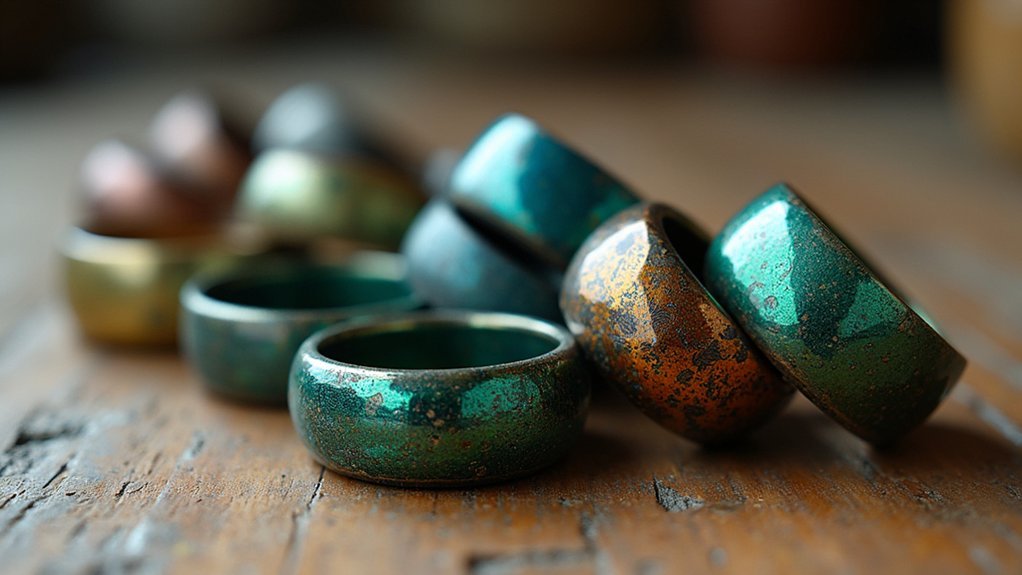



Leave a Reply